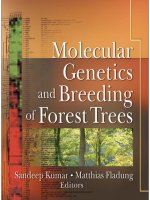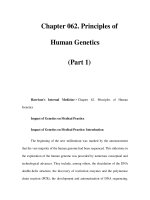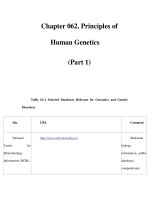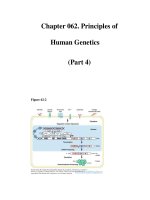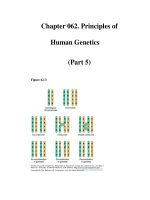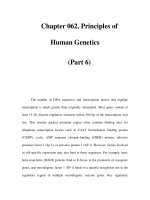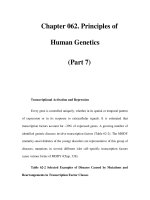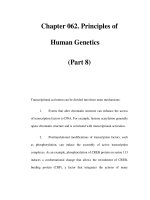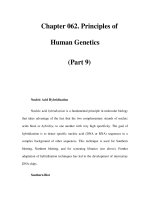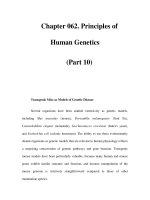Ebook Principles of plant genetics and breeding: Part 1
Bạn đang xem bản rút gọn của tài liệu. Xem và tải ngay bản đầy đủ của tài liệu tại đây (1.95 MB, 295 trang )
Principles of Plant Genetics and Breeding
Dedication
To my parents
Shiloh and Ernestina
With love and admiration
Principles of Plant Genetics
and Breeding
George Acquaah
Copyright © 2007 by George Acquaah
BLACKWELL PUBLISHING
350 Main Street, Malden, MA 02148-5020, USA
9600 Garsington Road, Oxford OX4 2DQ, UK
550 Swanston Street, Carlton, Victoria 3053, Australia
The right of George Acquaah to be identified as the Author of this Work
has been asserted in accordance with the UK Copyright, Designs, and Patents Act 1988.
All rights reserved. No part of this publication may be reproduced, stored
in a retrieval system, or transmitted, in any form or by any means,
electronic, mechanical, photocopying, recording or otherwise, except as
permitted by the UK Copyright, Designs, and Patents Act 1988, without the
prior permission of the publisher.
First published 2007 by Blackwell Publishing Ltd
1 2007
Library of Congress Cataloging-in-Publication Data
Acquaah, George.
Principles of plant genetics and breeding / George Acquaah.
p.
cm.
Includes bibliographical references and index.
ISBN-13: 978-1-4051-3646-4 (hardback : alk. paper)
ISBN-10: 1-4051-3646-4 (hardback : alk. paper)
1. Plant breeding. 2. Plant genetics. I. Title.
SB123.A334 2007
631.5′233—dc22
2006004754
A catalogue record for this title is available from the British Library.
Set in 10/12pt Galliard
by Graphicraft Limited, Hong Kong
Printed and bound in UK
by TJ International Ltd
The publisher’s policy is to use permanent paper from mills that operate a
sustainable forestry policy, and which has been manufactured from pulp
processed using acid-free and elementary chlorine-free practices.
Furthermore, the publisher ensures that the text paper and cover board
used have met acceptable environmental accreditation standards.
For further information on
Blackwell Publishing, visit our website:
www.blackwellpublishing.com
Contents
Industry highlights boxes, vii
Industry highlights box authors, ix
Preface, xi
Acknowledgments, xiii
Part I Underlying science and methods of plant breeding, 1
Section 1 Historical perspectives and importance of plant breeding, 2
1 History and role of plant breeding in society, 3
Section 2 General biological concepts, 16
2 The art and science of plant breeding, 17
3 Plant cellular organization and genetic structure: an overview, 35
4 Plant reproductive systems, 55
Section 3 Germplasm issues, 74
5 Variation: types, origin, and scale, 75
6 Plant genetic resources for plant breeding, 87
Section 4 Genetic analysis in plant breeding, 108
7 Introduction to concepts of population genetics, 109
8 Introduction to quantitative genetics, 121
9 Common statistical methods in plant breeding, 146
Section 5 Tools in plant breeding, 163
10 Sexual hybridization and wide crosses in plant breeding, 164
11 Tissue culture and the breeding of clonally propagated plants, 181
12 Mutagenesis in plant breeding, 199
13 Polyploidy in plant breeding, 214
14 Biotechnology in plant breeding, 231
15 Issues in the application of biotechnology in plant breeding, 257
Section 6 Classic methods of plant breeding, 281
16 Breeding self-pollinated species, 282
17 Breeding cross-pollinated species, 313
18 Breeding hybrid cultivars, 334
Section 7 Selected breeding objectives, 351
19 Breeding for physiological and morphological traits, 352
20 Breeding for resistance to diseases and insect pests, 367
21 Breeding for resistance to abiotic stresses, 385
22 Breeding compositional traits and added value, 404
Section 8 Cultivar release and commercial seed production, 417
23 Performance evaluation for crop cultivar release, 418
24 Seed certification and commercial seed multiplication, 435
vi
CONTENTS
25 International plant breeding efforts, 450
26 Emerging concepts in plant breeding, 462
Part II Breeding selected crops, 471
27
28
29
30
31
32
33
34
Breeding wheat, 472
Breeding corn, 485
Breeding rice, 498
Breeding sorghum, 509
Breeding soybean, 519
Breeding peanut, 529
Breeding potato, 537
Breeding cotton, 546
Glossary, 556
Appendix 1: Internet resources, 561
Appendix 2: Conversion rates, 563
Index, 564
Industry highlights boxes
Chapter 1
Normal Ernest Borlaug: the man and his passion
George Acquaah
Chapter 2
Introduction and adaptation of new crops
Jaime Prohens, Adrián Rodríguez-Burruezo, and Fernando Nuez
Chapter 3
No box
Chapter 4
Maize × Tripsacum hybridization and the transfer of
apomixis: historical review
Bryan Kindiger
Chapter 12
Current apple breeding programs to release apple scabresistant scion cultivars
F. Laurens
Chapter 13
Application of tissue culture for tall wheatgrass improvement
Kanyand Matand and George Acquaah
Chapter 14
Bioinformatics for sequence and genomic data
Hugh B. Nicholas, Jr., David W. Deerfield II, and
Alexander J. Ropelewski
Chapter 5
No box
Chapter 15
The intersection of science and policy in risk analysis of
genetically engineered plants
David A. Lee and Laura E. Bartley
Chapter 6
Plant genetic resources for breeding
K. Hammer, F. Heuser, K. Khoshbakht, and Y. Teklu
Chapter 16
Barley breeding in the United Kingdom
W. T. B. Thomas
Chapter 7
No box
Chapter 17
Developing a new cool-season perennial grass forage:
interspecific hybrids of Poa arachnifera × Poa secunda
Bryan Kindiger
Chapter 8
Recurrent selection with soybean
Joe W. Burton
Chapter 9
Multivariate analyses procedures: applications in plant
breeding, genetics, and agronomy
A. A. Jaradat
Chapter 10
The use of the wild potato species, Solanum etuberosum,
in developing virus- and insect-resistant potato varieties
Richard Novy
Chapter 11
Haploids and doubled haploids: their generation and
application in plant breeding
Sergey Chalyk
Chapter 18
Pioneer Hi-Bred International, Inc.: bringing seed value
to the grower
Jerry Harrington
Chapter 19
Bringing Roundup Ready® technology to wheat
Sally Metz
Chapter 20
Genetic improvement of cassava through biotechnology
Nigel J. Taylor
Chapter 21
Discovering genes for drought adaptation in sorghum
Andrew Borrell, David Jordan, John Mullet, Patricia
viii
INDUSTRY HIGHLIGHTS BOXES
Klein, Robert Klein, Henry Nguyen, Darrell Rosenow,
Graeme Hammer, and Bob Henzell
A. Fritz, B. S. Gill, K. S. Gill, S. Haley, K. K. Kidwell,
S. F. Kianian, N. Lapitan, H. Ohm, D. Santra, M. Sorrells,
M. Soria, E. Souza, and L. Talbert
Chapter 22
QPM: enhancing protein nutrition in sub-Saharan
Africa
Twumasi Afriyie
Chapter 28
Hybrid breeding in maize
F. J. Betrán
Chapter 23
MSTAT: a software program for plant breeders
Russell Freed
Chapter 29
Breeding rice
Anna Myers McClung
Chapter 24
Public release and registration of “Prolina” soybean
Joe W. Burton
and
Plant variety protection in Canada
B. Riché and D. J. Donnelly
Chapter 30
Sorghum breeding
William Rooney
Chapter 25
Plant breeding research at ICRISAT
P. M. Gaur, K. B. Saxena, S. N. Nigam, B. V. S. Reddy,
K. N. Rai, C. L. L. Gowda, and H. D. Upadhyaya
Chapter 26
An example of participatory plant breeding: barley at
ICARDA
S. Ceccarelli and S. Grando
Chapter 27
Bringing genomics to the wheat fields
K. A. Garland-Campbell, J. Dubcovsky, J. A. Anderson,
P. S. Baenziger, G. Brown-Guedira, X. Chen, E. Elias,
Chapter 31
Estimating inheritance factors and developing cultivars
for tolerance to charcoal rot in soybean
James R. Smith
Chapter 32
Peanut (Arachis hypogaea L.) breeding and root-knot
nematode resistance
Charles Simpson
Chapter 33
The breeding of potato
John E. Bradshaw
Chapter 34
Cotton breeding
Don L. Keim
Industry highlights box authors
Acquaah, G., Department of Agriculture and Natural Resources,
Langston University, Langston, OK 73050, USA
Afriyie, T., International Maize and Wheat Improvement
Center (CIMMYT), PO Box 5689, Addis Ababa, Ethiopia
Anderson, J. A., Department of Agronomy and Plant Genetics,
University of Minnesota, Twin Cities, St Paul, MN 55108,
USA
Baenziger, P. S., Department of Agronomy and Horticulture,
University of Nebraska-Lincoln, Lincoln, NE 68583, USA
Bartley, L. E., USDA-APHIS Biotechnology Regulatory
Services, Riverdale, MD 20737, USA
Betrán, F. J., Texas A&M University, College Station, TX
77843, USA
Borrell, A., Department of Primary Industries and Fisheries,
Hermitage Research Station, Warwick, Queensland 4370,
Australia
Bradshaw, J. E., Scottish Crop Research Institute, Invergowrie,
Dundee DD2 5DA, UK
Brown-Guedira, G., USDA-ARS Plant Science Research Unit,
North Carolina State University, Raleigh, NC 27606, USA
Burton, J. W., USDA Plant Science Building, 3127 Ligon
Street, Raleigh, NC 27607, USA
Ceccarelli, S., International Center for Agricultural Research
in the Dry Areas (ICARDA), PO Box 5466, Aleppo, Syria
Chalyk, S., 12 Goldfinch Court, Apt. 1007, Toronto M2R
2C4, Canada
Chen, X., USDA-ARS Wheat Genetics, Quality, Physiology,
and Disease Research Unit, Washington State University,
Pullman WA 99164, USA
Deerfield, D. W. II, Pittsburgh Supercomputing Center,
Pittsburgh, PA 15213, USA
Donnelly, D. J., Plant Science Department, McGill University,
Ste. Anne de Bellevue, QC H9X 3V9, Canada
Dubcovsky, J., Department of Agronomy and Range Science,
University of California at Davis, Davis, CA 95616, USA
Elias, E., Department of Plant Sciences, North Dakota State
University, Fargo, ND 58105, USA
Freed, R., Department of Crop and Soil Science, Michigan
State University, East Lansing, MI 48824, USA
Fritz, A., Department of Agronomy, Kansas State University,
Manhattan, KS 66506, USA
Garland-Campbell, K. A., USDA-ARS Wheat Genetics, Quality,
Physiology, and Disease Research Unit, Washington State
University, Pullman, WA 99164, USA
Gaur, P. M., International Crops Research Institute for the
Semi-Arid Tropics (ICRISAT), Patancheru 502 324, AP, India
Gill, B. S., Wheat Genetics Resource Center, Department of
Plant Pathology, Kansas State University, Manhattan, KS
66506, USA
Gill, K. S., Department of Crop and Soil Sciences, Washington
State University, Pullman, WA 99164, USA
Gowda, C. L. L., International Crops Research Institute for
the Semi-Arid Tropics (ICRISAT), Patancheru 502 324,
AP, India
Grando, S., International Center for Agricultural Research in
the Dry Areas (ICARDA), PO Box 5466, Aleppo, Syria
Haley, S., Department of Soil and Crop Sciences, Colorado
State University, Fort Collins, CO 80526, USA
Hammer, G., School of Land and Food, University of
Queensland, Queensland 4072, Australia
Hammer, K., Institute of Crop Science, Agrobiodiversity
Department, University Kassel, D-37213 Witzenhausen,
Germany
Harrington, J., Pioneer Hi-Bred International, Des Moines,
IA 50307, USA
Henzell, R., Department of Primary Industries and Fisheries,
Hermitage Research Station, Warwick, Queensland 4370,
Australia
Heuser, F., Institute of Crop Science, Agrobiodiversity Department, University Kassel, D-37213 Witzenhausen, Germany
Jaradat, A. A., USDA-ARS, Morris, 56267 MN, USA
Jordan, D., Department of Primary Industries and Fisheries,
Hermitage Research Station, Warwick, Queensland 4370,
Australia
Keim, D. L., Delta and Pine Land Company, One Cotton
Row, PO Box 157, Scott, MS 38772, USA
Khoshbakht, K., Institute of Crop Science, Agrobiodiversity
Department, University Kassel, D-37213 Witzenhausen,
Germany
Kianian, S. F., Department of Plant Sciences, North Dakota
State University, Fargo, ND 58105, USA
Kidwell, K. K., Department of Crop and Soil Sciences,
Washington State University, Pullman, WA 99164, USA
Kindiger, B., USDA-ARS Grazinglands Research Laboratory,
El Reno, OK 73036, USA
Klein, P., Institute for Plant Genomics and Biotechnology,
Texas A&M University, College Station, TX 77843, USA
Klein, R., USDA-ARS Southern Agricultural Research
Station, College Station, TX 77843, USA
Lapitan, N., Department of Soil and Crop Sciences, Colorado
State University, Fort Collins, CO 80526, USA
Laurens, F., UMR Génétique et Horticulture (GenHort)
(INRA/INH/UA), INRA Centre d’Angers, 49070
Beaucouzé, France
Lee, D. A., EPA Office of Research and Development,
8623N, Washington, DC 20460, USA
Matand, K., Department of Agriculture and Applied Sciences,
Langston University, Langston, OK 73050, USA
x
INDUSTRY HIGHLIGHTS BOX AUTHORS
McClung, M. A., USDA-ARS Dale Bumpers National Rice
Research Center and Beaumont Rice Research Unit, 1509
Aggie Drive, Beaumont, TX 77713, USA
Metz, S., Monsanto Corporation, 800 North Lindbergh Blvd,
St Louis, MO 63167, USA
Mullet, J., Institute for Plant Genomics and Biotechnology,
Texas A&M University, College Station, TX 77843, USA
Nguyen, H., Plant Sciences Unit and National Center for
Soybean Biotechnology, University of Missouri, Columbia,
MO 65211, USA (previously Texas Tech University,
Lubbock, USA)
Nicholas, H. B., Jr., Pittsburgh Supercomputing Center,
Pittsburgh, PA 15213, USA
Nigam, S. N., International Crops Research Institute for the
Semi-Arid Tropics (ICRISAT), Patancheru 502 324, AP,
India
Novy, R., USDA-ARS, Aberdeen, ID 83210, USA
Nuez, F., Instituto para la Conservación y Mejora de la
Agrodiversidad Valenciana, Universidad Politécnica de
Valencia, 46022 Valencia, Spain
Ohm, H., Department of Agronomy, Purdue University,
West Lafayette, IN 47907, USA
Prohens, J., Instituto para la Conservación y Mejora de la
Agrodiversidad Valenciana, Universidad Politécnica de
Valencia, 46022 Valencia, Spain
Rai, K. N., International Crops Research Institute for the SemiArid Tropics (ICRISAT), Patancheru 502 324, AP, India
Reddy, B. V. S., International Crops Research Institute for the
Semi-Arid Tropics (ICRISAT), Patancheru 502 324, AP,
India
Riché, B., Plant Science Department, McGill University, Ste.
Anne de Bellevue, QC H9X 3V9, Canada
Rodríguez-Burruezo, A., Instituto para la Conservación y
Mejora de la Agrodiversidad Valenciana, Universidad
Politécnica de Valencia, 46022 Valencia, Spain
Rooney, W., Texas A&M University, College Station, TX
77843, USA
Ropelewski, A. J., Pittsburgh Supercomputing Center,
Pittsburgh, PA 15213, USA
Rosenow, D., Texas A&M Agricultural Research and
Extension Center, Lubbock, TX 79403, USA
Santra, D., Department of Crop and Soil Sciences,
Washington State University, Pullman, WA 99164, USA
Saxena, K. B., International Crops Research Institute for the
Semi-Arid Tropics (ICRISAT), Patancheru 502 324, AP,
India
Simpson, C., Texas A&M University, College Station, TX
77843, USA
Smith, J. R., USDA-ARS Crop Genetics and Production
Research Unit, Stoneville, MS 38776, USA
Soria, M., Department of Agronomy and Range Science,
University of California at Davis, Davis, CA 95616, USA
Sorrells, M., Department of Plant Breeding, Cornell
University, Ithaca, NY 14853, USA
Souza, E., Aberdeen Research and Extension Center,
University of Idaho, Aberdeen, ID 83210, USA
Talbert, L., Department of Plant Sciences and Plant
Pathology, Montana State University, Bozeman, MT
59717, USA
Taylor, N. J., International Laboratory for Tropical Agricultural Biotechnology (ILTAB), Donald Danforth Plant
Science Center, St Louis, MO 63132, USA
Teklu, Y., Institute of Crop Science, Agrobiodiversity
Department, University Kassel, D-37213 Witzenhausen,
Germany
Thomas, W. T. B., Scottish Crop Research Institute,
Invergowrie, Dundee DD2 5DA, UK
Upadhyaya, H. D., International Crops Research Institute for
the Semi-Arid Tropics (ICRISAT), Patancheru 502 324,
AP, India
Preface
Plant breeding is an art and a science. May be it should be
added that it is also a business. Modern plant breeding is
a discipline that is firmly rooted in the science of genetics.
As an applied science, breeders are offered opportunities
to apply principles and technologies from several scientific
disciplines to manipulate plants for specific purposes.
This textbook, Principles of Plant Genetics and
Breeding, is designed to present plant breeding in a
balanced, comprehensive, and current fashion to students at the upper undergraduate level to early graduate
level. It is divided into two parts. Part I is devoted to
discussing the underlying science, and principles and
concepts of plant breeding, followed by a detailed discussion of the methods of breeding. Part II is devoted to
discussing the applications of the principles and concepts learned in Part I to breeding eight major field
crops. The principles and concepts discussed are generally applicable to breeding all plants. However, most
of the examples used in the book are drawn from the
breeding of field crops.
The book has several very unique components, some
of them never before presented in traditional plant
breeding textbooks at this level:
• The principles and concepts of genetics are presented in more detail in scope and depth than
obtains in other textbooks written at this level. But,
more importantly, the student is shown how the
principles are applied in plant breeding. As much as
possible, specific examples of application in plant
breeding are always given.
• Genetic variation is indispensable to plant breeding.
The issue of germplasm in plant breeding is discussed in detail, including genetic vulnerability in
crops, and germplasm collection and maintenance.
• The latest most versatile and most controversial
tools in the tool kit of plant breeders are the technologies of biotechnology, especially genetic engineering technologies. The underlying principles of
genetic engineering are discussed in detail. This is
followed by the application of biotechnology in
breeding, including molecular breeding of crops.
• Because of the controversial nature of genetic engineering, the book discusses in detail the issues of risk,
regulation, and public perception of biotechnology
as applied in plant breeding.
• A significant subject that is rarely discussed in
plant breeding books is the issue of intellectual
property (IP) and ethics. These issues are important
because they protect the breeder from abuse of their
inventions and provide incentive for research and
development of new cultivars. IP is thoroughly discussed in the book, with particular reference to plant
breeding.
• Some of the important yet often ignored subjects
in plant breeding books are prebreeding (or germplasm enhancement) and heterotic groups. These
concepts are effectively discussed.
• Both the conventional methods and contemporary
methods of plant breeding are discussed in detail,
pointing out their strengths and weaknesses, but
more importantly emphasizing their complementary use in modern plant breeding.
• Breeding objectives in plant breeding are as diverse
as plant breeders. Breeding objectives are discussed
according to effective themes. The presentation is
unique in that it includes discussions of the sources
of germplasm, and the genetics and progress in
breeding specific traits. Breeding for environmental
stresses is especially uniquely presented in this book.
• The discussion on breeding for disease and pest
resistance is comprehensive, incorporating the
current applications of genetic engineering in the
development of genetically modified breeding
materials.
• The cultivar release process is discussed to a good
depth and scope.
• The book is well illustrated to help students better
understand the principles and concepts discussed in
the book.
• Plant breeding methods have remained fairly
unchanged over the years. This book takes a bold
step in introducing, for the first time in a plant
breeding textbook at this level, the emerging concepts of decentralized participatory breeding and
organic plant breeding.
• Perhaps the most unique aspect of this book is the
incorporation of contributions from plant breeding
professionals. Industry professionals were invited to
present practical applications of plant breeding principles and concepts. In this way students are able to
see how the principles and concepts of breeding are
applied in real life to address specific plant breeding
xii
PREFACE
problems. The professionals were given the latitude to
make their presentation in the format of their choosing, without being too technical. Each participant
has provided a significant list of references that will
be of special interest to graduate students who wish
to further investigate the problems discussed.
The style of presentation throughout the book is easy
to follow and comprehend. Students are constantly re-
minded of previous topics of relevance to current topics
being discussed. This book is not only an excellent
teaching tool, but it is also suitable as a reference source
for professionals.
For instructors, if you did not receive an artwork
CD-ROM with your comp copy, please contact this
email address:
Acknowledgments
The author expresses sincere gratitude to the professionals from all over the world who contributed highlights to the chapters to significantly enhance the
instructional value of the textbook. Also, gratitude and
appreciation are hereby extended to the reviewers whose
comments and suggested were incorporated in the
preparation of the final manuscript. The reviewers
were: William Berzonsky, North Dakota State University; Paul Bilsborrow, University of Newcastle; Dennis
Decoteau, Pennsylvania State University; Majid R.
Foolad, Pennsylvania State University; Vernon Gracen,
Cornell University; Sean Mayes, Nottingham University; Habibur Rahman, University of Alberta; Andrew
Riseman, University of British Columbia; Lee Tarpley,
Texas A&M University; David Weaver, Auburn University; and Todd C. Wehner, North Carolina State
University.
Finally, the author reserves the highest gratitude for
Dr. J. C. El Shaddai, for ideas, guidance, encouragement,
and support throughout the duration of the project.
Part I
Underlying science and methods of
plant breeding
Part I of this book deals with the underlying basic science of plant breeding, emphasizing both classic and contemporary principles and concepts. All the pertinent genetic
concepts that are needed to understand and conduct plant breeding are discussed.
These include a consideration of Mendelian, population, and quantitative genetic principles and concepts. More importantly, the discussions show how plant breeders use these
scientific principles and concepts in their work. Examples of plant breeding applications
are provided.
The chapters also present a detailed discussion of the tools of plant breeding, including both classic and non-classic or contemporary tools, and emphasizing the complementarity of the two sets of tools. Then, a discussion of the methods of breeding
follows, indicating how plant breeding tools are used for breeding self-pollinated, crosspollinated, and clonally propagated species. Part I concludes with sections on the
cultivar release process, international plant breeding efforts, and emerging concepts in
plant breeding. Two contemporary breeding approaches that have never before been
formally addressed in plant breeding textbooks are discussed. It is important for students to be introduced to the most recent issues in the field of plant improvement so
that they may participate in the discussion.
Section 1
Historical perspectives and
importance of plant breeding
Chapter 1 History and role of plant breeding in society
Plant breeding as a human endeavor has its origins in antiquity, starting off simply as discrimination among
plant types to select and retain plants with the most desirable features. Remarkably, the practice of selection
remains the primary strategy for crop improvement, even though many technologically advanced techniques
have been added to the arsenal of the modern plant breeder. Plant breeding differs from evolution in that the
former is planned and purposeful. The student needs to appreciate how this formal activity of plant manipulation started and the advances made over the ages. More importantly, the student needs to appreciate the
achievements of plant breeding and its impact on society. This section introduces the student to the field of
plant breeding, highlighting its development, importance, and approaches.
1
History and role of plant
breeding in society
Purpose and expected outcomes
Agriculture is the deliberate planting and harvesting of plants and herding animals. This human invention has,
and continues to, impact on society and the environment. Plant breeding is a branch of agriculture that focuses on
manipulating plant heredity to develop new and improved plant types for use by society. People in society are aware
and appreciative of the enormous diversity in plants and plant products. They have preferences for certain varieties
of flowers and food crops. They are aware that whereas some of this variation is natural, humans with special expertise (plant breeders) create some of it. Generally, also, there is a perception that such creations derive from crossing
different plants. The tools and methods used by plant breeders have been developed and advanced through the years.
There are milestones in plant breeding technology as well as accomplishments by plant breeders over the years. This
introductory chapter is devoted to presenting a brief overview of plant breeding, including a brief history of its development, how it is done, and its benefits to society. After completing this chapter, the student should have a general
understanding of:
1
2
3
4
5
6
7
The historical perspectives of plant breeding.
The need and importance of plant breeding to society.
The goals of plant breeding.
Trends in plant breeding as an industry.
Milestones in plant breeding.
The accomplishments of plant breeders.
The future of plant breeding in society.
What is plant breeding?
Plant breeding is a deliberate effort by humans to nudge
nature, with respect to the heredity of plants, to an
advantage. The changes made in plants are permanent
and heritable. The professionals who conduct this task
are called plant breeders. This effort at adjusting the
status quo is instigated by a desire of humans to improve
certain aspects of plants to perform new roles or enhance
existing ones. Consequently, the term “plant breeding”
is often used synonymously with “plant improvement”
in modern society. It needs to be emphasized that the
goals of plant breeding are focused and purposeful.
Even though the phrase “to breed plants” often connotes the involvement of the sexual process in effecting a
desired change, modern plant breeding also includes the
manipulation of asexually reproducing plants (plants
that do not reproduce through the sexual process).
Breeding is hence about manipulating plant attributes,
structure, and composition, to make them more useful to humans. It should be mentioned at the onset that
it is not every plant character or trait that is amenable
to manipulation by breeders. However, as technology advances, plant breeders are increasingly able to
4
CHAPTER 1
accomplish astonishing plant manipulations, needless to
say not without controversy, as is the case involving the
development and application of biotechnology to plant
genetic manipulation. One of the most controversial of
these modern technologies is transgenesis, the technology by which gene transfer is made across natural biological barriers.
Plant breeders specialize in breeding different groups
of plants. Some focus on field crops (e.g., soybean, cotton), horticultural crops (e.g., vegetables), ornamentals,
fruit trees (e.g., citrus, apple), forage crops (e.g., alfalfa,
grasses), or turf species. More importantly, breeders
tend to focus on specific species in these groups. This
way, they develop the expertise that enables them to be
most effective in improving the species of their choice.
The principles and concepts discussed in this book are
generally applicable to breeding all species. However,
most of the examples supplied are from breeding
field crops.
Goals of plant breeding
The plant breeder uses various technologies and
methodologies to achieve targeted and directional
changes in the nature of plants. As science and technology advance, new tools are developed while old ones are
refined for use by breeders. Before initiating a breeding
project, clear breeding objectives are defined based on
factors such as producer needs, consumer preferences
and needs, and environmental impact. Breeders aim to
make the crop producer’s job easier and more effective
in various ways. They may modify plant structure so
it can resist lodging and thereby facilitate mechanical
harvesting. They may develop plants that resist pests
so the farmer does not have to apply pesticides or can
apply smaller amounts of these chemicals. Not applying
pesticides in crop production means less environmental
pollution from agricultural sources. Breeders may also
develop high-yielding varieties (or cultivars) so the
farmer can produce more for the market to meet
consumer demands while improving his or her income.
The term cultivar is reserved for variants deliberately
created by plant breeders and will be introduced more
formally later in the book. It will be the term of choice
in this book.
When breeders think of consumers, they may, for
example, develop foods with higher nutritional value
and that are more flavorful. Higher nutritional value
means reduced illnesses in society (e.g., nutritionally
related ones such as blindness or ricketsia) caused by the
consumption of nutrient-deficient foods, as obtains in
many developing regions where staple foods (e.g., rice,
cassava) often lack certain essential amino acids or nutrients. Plant breeders may also target traits of industrial
value. For example, fiber characteristics (e.g., strength)
of fiber crops such as cotton can be improved, while oil
crops can be improved to yield high amounts of specific
fatty acids (e.g., the high oleic content of sunflower
seed). The latest advances in technology, specifically
genetic engineering technologies, are being applied to
enable plants to be used as bioreactors to produce
certain pharmaceuticals (called biopharming or simply
pharming).
The technological capabilities and needs of societies
of old, restricted plant breeders to achieving modest
objectives (e.g., product appeal, adaptation to production environment). It should be pointed out that these
“older” breeding objectives are still important today.
However, with the availability of sophisticated tools,
plant breeders are now able to accomplish these genetic alterations in novel ways that are sometimes the
only option, or are more precise and more effective.
Furthermore, as previously indicated, they are able to
undertake more dramatic alterations that were impossible to attain in the past (e.g., transferring a desirable
gene from a bacterium to a plant!). Some of the reasons
why plant breeding is important to society are summarized next.
Concept of genetic manipulation of
plant attributes
The work of Gregor Mendel and the further advances
in science that followed his discoveries established that
plant characteristics are controlled by hereditary factors
or genes that consist of DNA (deoxyribose nucleic acid,
the hereditary material). These genes are expressed in an
environment to produce a trait. It follows then that in
order to change a trait or its expression, one may change
the nature or its genotype, and/or modify the nurture
(environment in which it is expressed). Changing the
environment essentially entails modifying the growing or production conditions. This may be achieved
through an agronomic approach, for example, the application of production inputs (e.g., fertilizers, irrigation).
Whereas this approach is effective in enhancing certain
traits, the fact remains that once these supplemental
environmental factors are removed, the expression of
the plant trait reverts to the status quo. On the other
hand, plant breeders seek to modify plants with respect
HISTORY AND ROLE OF PLANT BREEDING IN SOCIETY
to the expression of certain attributes by modifying the
genotype (in a desired way by targeting specific genes).
Such an approach produces an alteration that is permanent (i.e., transferable from one generation to the next).
Why breed plants?
The reasons for manipulating plant attributes or performance change according to the needs of society. Plants
provide food, feed, fiber, pharmaceuticals, and shelter
for humans. Furthermore, plants are used for aesthetic
and other functional purposes in the landscape and
indoors.
Addressing world food, feed, and nutritional needs
Food is the most basic of human needs. Plants are the
primary producers in the ecosystem (a community of
living organisms including all the non-living factors
in the environment). Without them, life on earth for
higher organisms would be impossible. Most of the
crops that feed the world are cereals (Table 1.1). Plant
breeding is needed to enhance the value of food crops,
by improving their yield and the nutritional quality of
their products, for healthy living of humans. Certain
plant foods are deficient in certain essential nutrients
to the extent that where these foods constitute the bulk
of a staple diet, diseases associated with nutritional
deficiency are often common. Cereals tend to be low in
lysine and threonine, while legumes tend to be low in
cysteine and methionine (both sulfur-containing amino
acids). Breeding is needed to augment the nutritional
quality of food crops. Rice, a major world food, lacks
Table 1.1 The 25 major food crops of the world, ranked
according to total tonnage produced annually.
1
2
3
4
5
6
7
8
9
10
Wheat
Rice
Corn
Potato
Barley
Sweet potato
Cassava
Grape
Soybean
Oat
11
12
13
14
15
16
17
18
19
20
Sorghum
Sugarcane
Millet
Banana
Tomato
Sugar beet
Rye
Orange
Coconut
Cottonseed oil
21
22
23
24
25
Apple
Yam
Peanut
Watermelon
Cabbage
5
pro-vitamin A (the precursor of vitamin A). The
“Golden Rice” project, currently underway at the
International Rice Research Institute (IRRI) in the
Philippines and other parts of the world, is geared
towards developing, for the first time ever, a rice cultivar with the capacity to produce pro-vitamin A. An
estimated 800 million people in the world, including
200 million children, suffer chronic undernutrition, with
its attendant health issues. Malnutrition is especially
prevalent in developing countries.
Breeding is also needed to make some plant products
more digestible and safer to eat by reducing their toxic
components and improving their texture and other
qualities. A high lignin content of the plant material
reduces its value for animal feed. Toxic substances occur
in major food crops, such as alkaloids in yam, cynogenic
glucosides in cassava, trypsin inhibitors in pulses, and
steroidal alkaloids in potatoes. Forage breeders are interested, among other things, in improving feed quality
(high digestibility, high nutritional profile) for livestock.
Addressing food needs for a growing world
population
In spite of a doubling of the world population in the
last three decades, agricultural production rose at an
adequate rate to meet world food needs. However, an
additional 3 billion people will be added to the world
population in the next three decades, requiring an
expansion in world food supplies to meet the projected
needs. As the world population increases, there would
be a need for an agricultural production system that is
apace with population growth. Unfortunately, arable
land is in short supply, stemming from new lands that
have been brought into cultivation in the past, or surrendered to urban development. Consequently, more
food will have to be produced on less land. This calls for
improved and high-yielding varieties to be developed by
plant breeders. With the aid of plant breeding, the yields
of major crops have dramatically changed over the years.
Another major concern is the fact that most of the population growth will occur in developing countries where
food needs are currently most serious, and where
resources for feeding people are already most severely
strained, because of natural or human-made disasters, or
ineffective political systems.
The need to adapt plants to environmental stresses
Source: J.R. Harlan. 1976. Plants and animals that nourish man. In:
Food and agriculture, A Scientific American Book. W.H. Freeman
and Company, San Francisco.
The phenomenon of global climatic change that is
occurring over the years is partly responsible for
6
CHAPTER 1
modifying the crop production environment (e.g., some
regions of the world are getting drier and others saltier).
This means that new cultivars of crops need to be bred
for new production environments. Whereas developed
economies may be able to counter the effects of unseasonable weather by supplementing the production
environment (e.g., by irrigating crops), poor countries
are easily devastated by even brief episodes of adverse
weather conditions. For example, the development and
use of drought-resistant cultivars is beneficial to crop
production in areas of marginal or erratic rainfall
regimes. Breeders also need to develop new plant types
that can resist various biotic (diseases, insect pests) and
other abiotic (e.g., salt, drought, heat, cold) stresses in
the production environment. Crop distribution can be
expanded by adapting crops to new production environments (e.g., adapting tropical plants to temperate
regions). The development of photoperiod-insensitive
crop cultivars would allow the expansion in production
of previously photoperiod-sensitive species.
The need to adapt crops to specific production
systems
Breeders need to produce plant cultivars for different
production systems to facilitate crop production and
optimize crop productivity. For example, crop cultivars
must be developed for rain-fed or irrigated production,
and for mechanized or non-mechanized production. In
the case of rice, separate sets of cultivars are needed
for upland production and for paddy production. In
organic production systems where pesticide use is highly
restricted, producers need insect- and disease-resistant
cultivars in crop production.
Developing new horticultural plant varieties
The ornamental horticultural production industry
thrives on the development of new varieties through
plant breeding. Aesthetics is of major importance to
horticulture. Periodically, ornamental plant breeders
release new varieties that exhibit new colors and other
morphological features (e.g., height, size, shape). Also,
breeders develop new varieties of vegetables and fruits
with superior yield, nutritional qualities, adaptation, and
general appeal.
Satisfying industrial and other end-use requirements
Processed foods are a major item in the world food
supply system. Quality requirements for fresh produce
meant for the table are different from those used in the
food processing industry. For example, there are table
grapes and grapes bred for wine production. One of
the reasons why the first genetically modified (GM)
crop (produced by using genetic engineering tools to
incorporate foreign DNA) approved for food, the
FlavrSavr® tomato, did not succeed was because the
product was marketed as a table or fresh tomato, when
in fact the gene of interest was placed in a genetic background for developing a processing tomato variety.
Other factors contributed to the demise of this historic
product. Different markets have different needs that
plant breeders can address in their undertakings. For
example, the potato is a versatile crop used for food
and industrial products. Different varieties are bred for
baking, cooking, fries (frozen), chipping, and starch.
These cultivars differ in size, specific gravity, and sugar
content, among other properties. A high sugar content
is undesirable for frying or chipping because the sugar
caramelizes under high heat to produce undesirable
browning of fries and chips.
Plant breeding through the ages
Plant breeding as a conscious human effort has ancient
origins.
Origins of agriculture and plant breeding
In its primitive form, plant breeding started after the
invention of agriculture, when people of primitive cultures switched from a lifestyle of hunter-gatherers to
sedentary producers of selected plants and animals.
Views of agricultural origins range from the mythological to ecological. This lifestyle change did not occur
overnight but was a gradual process during which
plants were transformed from being independent, wild
progenitors, to fully dependent (on humans) and
domesticated varieties. Agriculture is generally viewed
as an invention and discovery. During this period,
humans also discovered the time-honored and most
basic plant breeding technique – selection, the art of
discriminating among biological variation in a population to identify and pick desirable variants. Selection
implies the existence of variability. In the beginnings of
plant breeding, the variabilities exploited were the naturally occurring variants and wild relatives of crop species.
Furthermore, selection was based solely on the intuition, skill, and judgment of the operator. Needless to
say, this form of selection is practiced to date by farmers
HISTORY AND ROLE OF PLANT BREEDING IN SOCIETY
7
in poor economies, where they save seed from the
best-looking plants or the most desirable fruit for planting the next season. These days, scientific techniques
are used in addition to the aforementioned qualities to
make the selection process more precise and efficient.
Even though the activities described in this section
are akin to some of those practiced by modern plant
breeders, it is not being suggested that primitive crop
producers were necessarily conscious of the fact that
they were nudging nature to their advantage as modern
breeders do.
invaluable to modern plant breeding. In 1727, Louis
Leveque de Vilmorin of the Vilmorin family of seed
growers founded the Vilmorin Breeding Institute in
France as the first institution dedicated to plant breeding and the production of new cultivars. There, another
still commonly used breeding technique – progeny
test (growing the progeny of a cross for the purpose
of evaluating the genotype of the parent) – was first
used to evaluate the breeding value of a single plant.
Selected milestones in plant breeding are presented in
Table 1.2.
Plant breeding past (pre-Mendelian)
Plant breeding present (post-Mendelian)
Whereas early plant breeders did not deliberately create
new variants, modern plant breeders are able to create
new variants that previously did not occur in natural
populations. It is difficult to identify the true beginnings
of modern plant breeding. However, certain early
observations by certain individuals helped to lay the
foundation for the discovery of the modern principles of
plant breeding. It has been reported that archaeological
records indicate that the Assyrians and Babylonians
artificially pollinated date palm, at least 700 bc. R. J.
Camerarius (aka Rudolph Camerer) of Germany is credited with first reporting sexual reproduction in plants
in 1694. Through experimentation, he discovered that
pollen from male flowers was indispensable to fertilization and seed development on female plants. His work
was conducted on monoecious plants (both sexes occur
on separate parts of the plant, e.g., spinach and maize).
However, it was Joseph Koelreuter who conducted
the first known systematic investigations into plant
hybridization (crossing of genetically dissimilar parents)
of a number of species, between 1760 and 1766.
Similarly, in 1717, Thomas Fairchild, an Englishman,
conducted an interspecific cross (a cross between two
species) between sweet william (Dianthus berbatus)
and D. caryophyllis, to obtain what became known as
Fairchild’s sweet william. Another account describes
an observation in 1716 by an American, Cotton Mather,
to the effect that ears from yellow corn grown next to
blue or red corn had blue and red kernels in them. This
suggested the occurrence of natural cross-pollination.
Maize is one of the crops that has received extensive
breeding and genetic attention in the scientific community. As early as 1846, Robert Reid of Illinois was credited with developing what became known as “Reid’s
Yellow Dent”. The landmark work by Swedish botanist,
Carolus Linnaeus (1707–1778), which culminated in
the binomial systems of classification of plants, is
Modern plant breeding depends on the principles of
genetics, the science of heredity to which Gregor
Mendel made some of its foundational contributions.
Mendel’s original work on the garden pea was published
in 1865. It described how factors for specific traits are
transmitted from parents to offspring and through
subsequent generations. His work was rediscovered
in 1900, with confirmation by E. von Tschermak, C.
Correns, and H. de Vries. These events laid the foundation for modern genetics. Mendel’s studies gave birth to
the concept of genes (and the discipline of genetics),
factors that encode traits and are transmitted through
the sexual process to the offspring. Further, his work
resulted in the formulation of the basic rules of heredity
that are called Mendel’s laws.
One of the earliest applications of genetics to plant
breeding was made by the Danish botanist, Wilhelm
Johannsen. In 1903, Johannsen developed the pureline theory while working on the garden bean. His
work confirmed an earlier observation by others that
the techniques of selection could be used to produce
uniform, true-breeding cultivars by selecting from
the progeny of a single self-pollinated crop (through
repeated selfing) to obtain highly homozygous lines
(true breeding), which he later crossed. Previously, H.
Nilson had demonstrated that the unit of selection was
the plant. The products of the crosses (called hybrids)
yielded plants that outperformed either parent with
respect to the trait of interest (the concept of hybrid
vigor). Hybrid vigor (or heterosis) is the foundation of
modern hybrid crop production programs.
In 1919, D. F. Jones took the idea of a single cross
further by proposing the double-cross concept, which
involved a cross between two single crosses. This technique made the commercial production of hybrid corn
seed economical. The application of genetics in crop
improvement has yielded spectacular successes over the
8
CHAPTER 1
Table 1.2 Selected milestones in plant breeding
9000 bc
3000 bc
1000 bc
700 bc
1694
1716
1719
1727
1753
1761–1766
1847
1866
1899
1900
1903
1904–1905
1908–1909
1908–1910
1909
1917
1926
1934
1935
1940
1944
1945
1950
1953
1970
1994
1995
1996
2004
First evidence of plant domestication in the hills above the Tigris river
Domestication of all important food crops in the Old World completed
Domestication of all important food crops in the New World completed
Assyrians and Babylonians hand pollinate date palms
Camerarius of Germany first to demonstrate sex in plants and suggested crossing as a method to obtain new plant
types
Mather of USA observed natural crossing in maize
Fairchild created first artificial hybrid (carnation × sweet william)
Vilmorin Company of France introduced the pedigree method of breeding
Linnaeus published Species plantarium. Binomial nomenclature born
Koelreuter of Germany demonstrated that hybrid offspring received traits from both parents and were
intermediate in most traits; produced first scientific hybrid using tobacco
“Reid’s Yellow Dent” maize developed
Mendel published his discoveries in Experiments in plant hybridization, cumulating in the formulation of laws of
inheritance and discovery of unit factors (genes)
Hopkins described the ear-to-row selection method of breeding in maize
Mendel’s laws of heredity rediscovered independently by Correns of Germany, de Vries of Holland, and von
Tschermak of Austria
The pure-line theory of selection developed
Nilsson-Ehle proposed the multiple factor explanation for inheritance of color in wheat pericarp
Hardy of England and Weinberg of Germany developed the law of equilibrium of populations
East published his work on inbreeding
Shull conducted extensive research to develop inbreds to produce hybrids
Jones developed first commercial hybrid maize
Pioneer Hi-bred Corn Company established as first seed company
Dustin discovered colchicines
Vavilov published The scientific basis of plant breeding
Harlan used the bulk breeding selection method in breeding
Avery, MacLeod, and McCarty discovered DNA is hereditary material
Hull proposed recurrent selection method of breeding
McClintock discovered the Ac-Ds system of transposable elements
Watson, Crick, and Wilkins proposed a model for DNA structure
Borlaug received Nobel Prize for the Green Revolution
Berg, Cohen, and Boyer introduced the recombinant DNA technology
“FlavrSavr” tomato developed as first genetically modified food produced for the market
Bt corn developed
Roundup Ready® soybean introduced
Roundup Ready® wheat developed
years, one of the most notable being the development
of dwarf, environmentally responsive cultivars of wheat
and rice for the subtropical regions of the world. These
new plant materials transformed food production in
these regions in a dramatic fashion, and in the process
became dubbed the Green Revolution. This remarkable achievement in food production is discussed below.
Mutagenesis (the induction of mutations using mutagenic agents (mutagens) such as radiation or chemicals)
became a technique for plant breeding in the 1920s
when researchers discovered that exposing plants to Xrays increased the variation in plants. Mutation breeding
accelerated after World War II, when scientists included
nuclear particles (e.g., alpha, protons, and gamma) as
mutagens for inducing mutations in organisms. Even
though very unpredictable in outcome, mutagenesis has
been successfully used to develop numerous mutant
varieties.
In 1944, DNA was discovered to be the genetic material. Scientists then began to understand the molecular
basis of heredity. New tools (molecular tools) are being
developed to facilitate plant breeding. Currently, scientists are able to circumvent the sexual process to transfer genes from one parent to another. In fact, genes
HISTORY AND ROLE OF PLANT BREEDING IN SOCIETY
Achievements of modern plant breeders
The achievements of plant breeders are numerous, but
may be grouped into several major areas of impact –
yield increase, enhancement of compositional traits,
crop adaptation, and the impact on crop production
systems.
Yield increase
Yield increase in crops has been accomplished in a
variety of ways including targeting yield per se or its
components, or making plants resistant to economic
diseases and insect pests, and breeding for plants that
are responsive to the production environment. Yields
of major crops (e.g., corn, rice, sorghum, wheat, soybean) have significantly increased in the USA over the
years (Figure 1.1). For example, the yield of corn rose
from about 2,000 kg/ha in the 1940s to about 7,000
kg/ha in the 1990s. In England, it took only 40 years
for wheat yields to rise from 2,000 to 6,000 kg/ha.
These yield increases are not totally due to the genetic
potential of the new crop cultivars but also due to
improved agronomic practices (e.g., application of fertilizer, irrigation). Crops have been armed with disease
resistance to reduce yield loss. Lodging resistance also
reduces yield loss resulting from harvest losses.
Enhancement of compositional traits
Breeding for plant compositional traits to enhance
nutritional quality or to meet an industrial need are
major plant breeding goals. High protein crop varieties
(e.g., high lysine or quality protein maize) have been
160
Corn
Wheat
Soybean
140
120
Grain yield (bu/ac)
can now be transferred from virtually any organism
to another. This newest tool, specifically called genetic engineering, has its proponents and distracters.
Current successes include the development of insect
resistance in crops such as maize by incorporating a gene
from the bacterium Bacillus thuringiensis. Cultivars
containing an alien gene for insect resistance from this
particular organism are called Bt cultivars, diminutive of
the scientific name of the bacterium. The products of
the application of this alien gene transfer technology are
generally called genetically modified (GM) or transgenic
products. Plant biotechnology, the umbrella name for
the host of modern plant manipulation techniques, has
produced, among other things, molecular markers to
facilitate the selection process in plant breeding.
9
100
80
60
40
20
0
1950
1964
1972
1982
Year
1992
2002
Figure 1.1 The yield of major world food crops is steadily
rising, as indicated by the increasing levels of crops
produced in the US agricultural system. A significant
portion of this rise is attributable to the use of improved
crop cultivars by crop producers. bu/ac, bushels per acre.
Source: Drawn with data from the USDA.
produced for use in various parts of the world. For
example, different kinds of wheat are needed for different kinds of products (e.g., bread, pasta, cookies,
semolina). Breeders have identified the quality traits
associated with these uses and have produced cultivars
with enhanced expression of these traits. Genetic engineering technology has been used to produce high oleic
sunflower for industrial use, while it is also being used to
enhance the nutritional value of crops (e.g., pro-vitamin
A “Golden Rice”). The shelf-life of fruits (e.g., tomato)
has been extended through the use of genetic engineering techniques to reduce the expression of compounds
associated with fruit deterioration.
Crop adaptation
Crop plants are being produced in regions to which they
are not native, because breeders have developed cultivars with modified physiology to cope with variations,
for example, in the duration of day length (photoperiod). Photoperiod-insensitive cultivars will flower
and produce seed under any day length conditions. The
duration of the growing period varies from one region
of the world to another. Early maturing cultivars of crop
plants enable growers to produce a crop during a short
window of opportunity, or even to produce two crops in
10
CHAPTER 1
one season. Furthermore, early maturing cultivars can
be used to produce a full season crop in areas where
adverse conditions are prevalent towards the end of the
normal growing season. Soils formed under arid conditions tend to accumulate large amounts of salts. In order
to use these lands for crop production, salt-tolerant
(saline and aluminum tolerance) crop cultivars have
been developed for certain species. In crops such as
barley and tomato, there are commercial cultivars in use,
with drought, cold, and frost tolerance.
The Green Revolution
Producing enough food to feed the world’s ever increasing population has been a lingering concern of modern
societies. Perhaps the most notable essay on food and
population dynamics was written by Thomas Malthus in
1798. In this essay, “Essay on the principles of population”, he identified the geometric role of natural population increase in outrunning subsistence food supplies.
He observed that unchecked by environmental or social
constraints it appears that human populations double
every 25 years, regardless of the initial population size.
Because population increase, according to this observation, was geometric, whereas food supply at best was
arithmetic, there was implicit in this theory pessimism
about the possibility of feeding ever growing populations. Fortunately, mitigating factors such as technological advances, advances in agricultural production,
changes in socioeconomics, and political thinking of
modern society, has enabled this dire prophesy to
remain unfulfilled.
Unfortunately, the technological advances in the
20th century primarily benefited the industrial countries, leaving widespread hunger and malnutrition to
persist in most developing countries. Many of these
nations depend on food aid from industrial countries for
survival. In 1967, a report by the US President’s Science
Advisory Committee came to the grim conclusion that
“the scale, severity and duration of the world food problem are so great that a massive, long-range, innovative
effort unprecedented in human history will be required
to master it”. The Rockefeller and Ford Foundations,
acting on this challenge, proceeded to establish the first
international agricultural system to help transfer the
agricultural technologies of the developed countries to
the developing countries. These humble beginnings led
to a dramatic impact on food production in the third
world, especially Asia, which would be dubbed the
Green Revolution, a term coined in 1968 by the USAID
Administrator, William S. Gaud.
The Green Revolution started in 1943 when the
Mexican government and the Rockefeller Foundation co-sponsored a project, the Mexican Agricultural
Program, to increase food production in Mexico. The
first target crop was wheat, and the goal was to increase
wheat production by a large margin. Using an interdisciplinary approach, the scientific team headed by Norman
Borlaug, a wheat breeder at the Rockefeller Foundation,
started to assemble genetic resources (germplasm) of
wheat from all over the world (East Africa, Middle East,
South Asia, Western Hemisphere). The key genotypes
used by Norman Borlaug in his breeding program were
the Japanese “Norin” dwarf genotypes supplied by
Burton Bayles of the United States Department of
Agriculture (USDA) and a segregating (F2) population
of “Norin 10” crossed with “Brevor”, a Pacific
Northwest wheat, supplied by Orville Vogel of the
USDA. These introductions were crossed with indigenous (Mexican) wheat that had adaptability (to temperature, photoperiod) to the region and were disease
resistant, but were low yielding and prone to lodging.
The team was able to develop lodging-resistant cultivars
through introgression of dwarf genes from semidwarf
cultivars from North America. This breakthrough
occurred in 1953. Further crossing and selection
resulted in the release of the first Mexican semidwarf
cultivars, “Penjamo 62” and “Pitic 62”. Together with
other cultivars, these two hybrids dramatically transformed wheat yields in Mexico, eventually making
Mexico a major wheat exporting country. The successful wheat cultivars were introduced into Pakistan, India,
and Turkey in 1966, with similar results of outstanding
performance. During the period, wheat production
increased from 300,000 to 2.6 million tons/year; yields
per unit area increased from 750 to 3,200 kg/ha.
The Mexican model (interdisciplinary approach,
international team effort) for agricultural transformation was duplicated in rice in the Philippines in 1960.
This occurred at the IRRI. The goal of the IRRI team
was to increase productivity of rice in the field. Rice
germplasm was assembled. Scientists determined that,
like wheat, a dwarf cultivar that was resistant to lodging,
amenable to high density crop stand, responsive to fertilization and highly efficient in partitioning of photosynthates or dry matter to the grain, was the cultivar to
breed.
In 1966, the IRRI released a number of dwarf rice
cultivars to farmers in the Philippines. The most success
was realized with IR8, which was early maturing (120
days), thus allowing double cropping in certain regions.
The key to the high yield of the IR series was their
